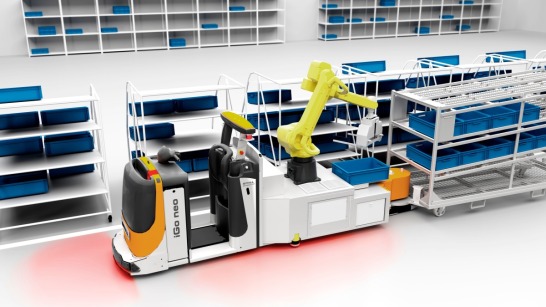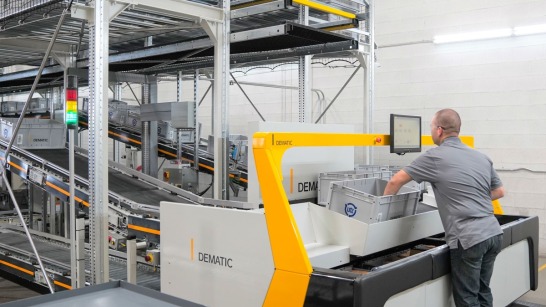The project is funded by Germany's Federal Ministry for Economic Affairs and Energy as part of the PAiCE – Digital Technologies for The Private Sector -- technology initiative (see box). It uses prototype solutions in specific applications to highlight the opportunities that come from integrating and using innovative digital technologies. “The various objectives include optimizing the use of resources and ensuring that production is as environmentally friendly as possible," explains Gerd Hembach from the German Aerospace Center, which is responsible for the project. He adds, "The new QBIIK FTF robot system makes value-added processes more efficient while using fewer resources.”
Robot system can 'learn' via user interface
The project team is developing an adaptive autonomous picking system which combines autonomous technology benefits with human capabilities. Key to the project is a remote-controlled truck with a gripper robot capable of moving euro containers with a maximum weight of 15 kilograms (33 lbs). The vehicle can position itself within the warehouse, navigate to its destination and reach for the goods ordered, all entirely autonomously. A human-machine interface can be used to request remote human support via a virtual reality user interface in the event a gripping process fails. In this scenario, an individual takes control of the robot to complete the identification and gripping processes. The human intervention allows the robot system to 'learn' how to handle new work processes so that it can acccomplish new tasks in the future.
The iGo neo has all the right ingredients
The iGo neo, from industrial truck manufacturer STILL, is the vehicle platform for the QBIIK project. The STILL engineers incorporated intelligent robot technology, and thus cognitive abilities, during the picking truck’s development. The result is an autonomous system perfectly customized to meet the order picking task requirements in areas such as traditional retail, e-commerce and spare part sales. “The truck's equipment has been hugely beneficial in this project and we have retained more than 90 percent of the existing software frameworks in the iGo neo and have made only minor modifications,” notes Bengt Abel, responsible for the QBIIK project at STILL and its holding company, KION Group. “Because the vehicle is so autonomous and we are so familiar with it, we have had more time to focus on other tasks.”
Virtual safety fence increases safety
And there have been plenty of other tasks to tackle. A risk analysis identified 116 hazardous situations that could come up from the demonstrator vehicle. “Which is why we spent a lot of time looking at the necessary safety measures," says Abel, adding,"The biggest issue was that there was no standard to fall back on for this type of application, where a robot is mounted on an autonomously moving vehicle. Simply adding a cage around the vehicle was not feasible in this case." They resolved it by installing a scanner which creates a safety zone around the iGo neo. When an individual or an object enters the zone, the truck and the robot arm are immediately de-activated.
Teach-in processes now concluded
Another development priority has been the autonomous truck’s ability to orient itself within its environment. For this, the STILL developers used Monte Carlo localization (MCL), a sample-based approach for estimating the position and orientation of a mobile system. The initial tests were run in the warehouse at project partner Audi. With the help of learning trips, waypoints were recorded, which the autonomous system uses to find its way around. The iGo neo can then freely move between them using fixed objects such as walls and pillars as orientation points. “During the initial tests, the learning trips had to be done by us, but in the future is to have system users carry out these trips themselves,” says Abel.
The containers on the shelves are detected in several stages by an artificial neural network using a combination of imaging sensors, a 3D camera and tactile proximity sensors.
All in all, STILL development engineer Abel is quite pleased with the project's progress. “We still have some work to do to speed up the truck and the robot because it is currently too slow to use in the field,” he says. However, this is largely due to the safety requirements which are still rather high. Hembach from the German Aerospace Center is also satisfied with the latest results: “The consortium has developed reliable results in under four years and implemented them in an application. I anticipate seeing a prototype of the entire system by the time the project concludes in June.”


_image_546x307.jpg)
